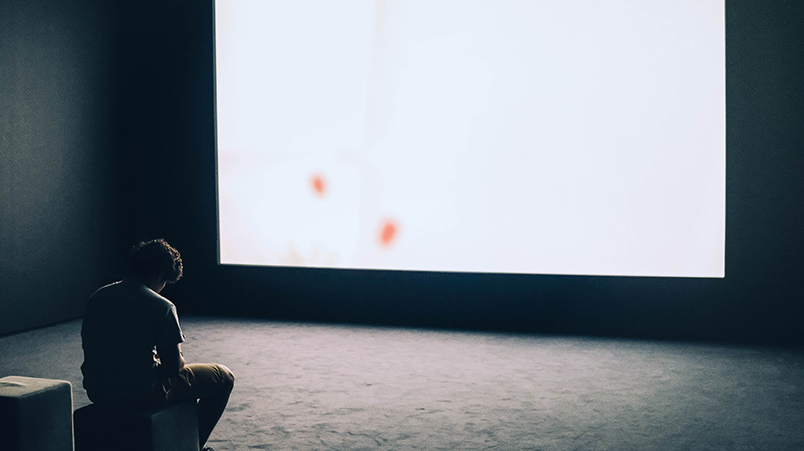Inside BVOD's beehive: CPMs down 20% as agencies shift spend, catch-up viewing accelerates

Vizeum CEO Ash Earnshaw: "Make no mistake, video has been the least impacted but still, BVOD prices would have dropped by up to 30%, dependent on the client brief."
Bored binge-watching is booming as audiences flock to broadcast video on demand (BVOD). Networks have begun dealing with CPMs falling circa 20% although brands remain hesitant on spend with media agencies claiming only 30% of the market is ready to play.
What you need to know:
- BVOD viewing has surged 36% during the lockdown period
- Despite audience growth, agencies are reporting CPMs dropping between 20-30%
- Networks have also begun to adjust cancellation deadlines on a case-to-case basis - in some instances they're requiring just a week's notice.
- While the networks are adjusting pricing and facilitating budget shifts, some say just 30% of marketers are receptive. The rest remain focused on internal logistics.
- Trade desks and programmatic teams reported 60-70% increases in spend during the first two weeks of lockdown.
- It has since plateaued, likely due to the 'panic and pull' response in outdoor and cinema activity
- Agencies are the on the fence about the future of BVOD post-COVID. Some believe the lockdown is a "catalyst" that will see more users latch on to the respective platforms, with brand investment to follow.
Stable but not the saviour
Two months ago many may have snickered at the idea of people binge watching long-time soap opera The Bold and the Beautiful but Ten's sales boss Rod Prosser points out in the weeks since lockdown it's become one of the best performing shows on 10Play.
Meanwhile, Nine's director of digital sales Nick Young says its investment in NBCUniversal content, which includes Keeping Up with the Kardashians and The Real Housewives franchise, will prove invaluable with audiences keen to get their fill of reality TV.
BVOD, much like TV and newsmedia, is seeing serious audience and subscriber growth. ThinkTV reports that since the lockdown, BVOD viewing has gone up another 36%.
However, the network's are not immune to the belt-tightening that is causing the ad market to contract 20-30%, with multiple agencies confirming CPMs are back the same.
Vizeum CEO Ash Earnshaw told Mi3 that even with each network making different deals, it feels as though only 30% of the market are receptive. The rest are still reassessing their media strategy as well as those well-documented sectors which have disappeared overnight.
"Make no mistake, video has been the least impacted by the changes but still, BVOD prices would have dropped by up to 30%, dependent on the client brief," he says. "We have been keen to drive value for our clients at a time when they need it, whilst still supporting publishers – this isn’t, and shouldn't become a race to the bottom."
According to one industry insider, while BVOD might be seeing small levels of growth, likely due to advertisers pulling out of other highly impacted channels such as outdoor and cinema, that doesn't mean the overall spend on screens is increasing.
"If 20 cents out of the dollar was going to BVOD in a traditional video spend, that might have crept up to 25 cents now but the value of the dollar itself has gone down to 80 cents," they say. "So don't go thinking the increase is indicative of the market, spend is still back, BVOD is just keeping stable."
Commercial Director for Publicis, Jodi Fraser, disagrees. She says it's unlikely for BVOD to be the "saviour" during this crisis and that brands aren't pulling spend from one channel and dropping it into another.
With Publicis handling a portfolio of FMCG clients, she says its business as usual and hasn't seen any significant growth in spend when it comes to TV or BVOD.
"This idea that you pull out of cinema and outdoor and dump it into TV or BVOD isn’t right. The people who are pulling out of those mediums are doing it for logistical reasons, not audience," Fraser says. "It's hard to see there being growth when some of these platforms' inventory is mainly advertising the network's programming."
"What we are seeing is exactly the same as any other media, if we are pulling out, we are pulling out of everything."
Brett Poole, managing director of GroupM’s Addressable TV business Finecast, says the broadcasters have invested a lot into the tech and the BVOD apps but acknowledged that there were some difficulties within the BVOD ecosystem.
He says there are still frequency issues, back-to-back ads and currently, while there are obvious reach benefits with BVOD, not being able to measure reach to a "gold standard" and only being able to optimise on frequency as a proxy is still an ongoing struggle.
"As with anything, there is a value equation that clients and agencies work towards and there are multiple factors that drive that," he says.
"Particularly in these times you’re looking at consumer experience, trends, sentiment, programming strategies to leverage the right optimisation to deliver value to a client– price is just one element."
A long-term catalyst?
Looking beyond the crisis, Managing Partner at Hatched Media Adrian Roeling sees the current audience growth within BVOD as a "huge catalyst" for long-term change for the channel.
He says the pausing of live sport and the slowed return of some international and local competitions will only further grow audiences even after restrictions are slowly wound back.
"Smart media planners should already be looking at how they can recalibrate their media mix to feature BVOD more predominately, especially given the lighter restrictions still don't necessarily mean people will be out in droves," Roeling says.
"Keeping that in mind and looking at the current state of consumption, video will certainly be one of the first to bounce back, while others such as outdoor and cinema, in particular, will still be heavily reliant on returning to 'normal life'."
PHD boss Mark Jarrett says the rapid adoption of technology in multiple facets of personal and professional day-to-day life works in BVOD's favour, with demographics previously adverse to signing up to the platforms more likely to "test and learn".
"What's coming out of this situation is an 'accelerator effect'," Jarrett says. "Take things like Zoom and Microsoft teams, before this, they were similar to BVOD - lots of people used them of course, but a lot more uninitiated workers have suddenly been forced to quickly add the two programs to their daily lives."
"It's possible years of technological adoption could be crammed into these next two to three months and considering the current rate of growth in BVOD consumption, this could be a reason why its climbs faster and further."
While sharing the view of BVOD acceleration through COVID, IPG Mediabrands' Mark Coad questions the sustainability of the networks' content libraries.
He says the major TV players may find people struggle to delve past the tentpole layer of programming on offer, such as the likes of Married at First Sight, House Rules and MasterChef.
"BVOD is up by the simple virtue of people being home all day, however, the real challenge for networks will be keeping audiences engaged as they continue to burn through content libraries and then beyond," Coad says.
"The future of TV content and production still hangs in the balance and without a firm date as to when that can resume, the problem then centres around what each network has to offer and whether it's good enough to compete with the evolve SVOD offering."
Picking through programmatic
Early reports from programmatic players claimed that BVOD buys grew as much as 60-70% in the first two weeks of the COVID lockdown.
Amobee ANZ MD Liam Walsh says programmatic platforms likely saw a faster response due to clients quickly switching budget across from other areas such as display and OOH.
He says the benefits of programmatic were built for situations where fast responses are required and is likey to be the reason behind these early figures.
"The increase in streams might plateau in the short term but the transformation to digital won't," Walsh says.
"When lockdown is lifted many things will go back to where they were prior to COVID. However consumer muscle memories will change for good and they'll continue to stream more and more of their video."
Walsh says taking advantage of behavioural changes as quickly as possible should be another incentive for agencies to trade BVOD in an automated way, however, Amobee did expect BVOD supply to start getting tighter over the coming weeks as eyeballs fall off slightly and advertiser demand starts to increase.
The Trade Desk's James Bayes says as a result of the current situation, a greater focus is going to move onto data-driven decisions, performance media and results as it there becomes a sharper focus on ad spend.
Additionally, the accountability for every dollar that gets spent, as brands come out the other side of COVID, is only going to be fixated on even further.
For that reason, alongside the rapid audience growth, he believes BVOD is most likely to be a formidable channel for both marketers looking to continue their extension of TV reach strategies but also for those looking for a "brand-safe and addressable" lower-cost alternative to its linear counterpart.
"BVOD is reaching a point of scale where it is big enough to stand on its own two feet and also gives a certain type of advertiser to use the channel in a way they couldn’t use linear TV," Bayes says. Anything that is addressable or that can be directly correlated to performance is going to do well out of this in H2."
Network optimism
While the networks acknowledged that there were ongoing conversations around pricing and cancellations, they maintained that it was on a case-by-case basis and there was no flat reduction.
Seven Chief Revenue Officer Kurt Burnette told Mi3 it was adjusting where it could but emphasised that BVOD was maintaining its audience trajectory, with the hope the influx of new subscribers (up roughly 20% for 7Plus) would ensure revenue bounced back when the lockdown ended.
"What we're seeing is the direct buying of BVOD in decline. This is mainly due to how it was sold as part of an extension of TV reach and into larger integrations deals, which are currently on hold," Burnette says.
"But if you look at programmatic, they've begun to take hold of some of that inventory, yet this is all short-term. What we need to focus on is keeping those audiences engaged even after they return to normal life."
Young says while there has been small areas of growth in the channel, there have also been "interesting kernels" of change from a data prespective.
He says some clients who were previously advertising throughout mediums such as cinema, which has shuttered completely during lockdown, have looked to find in 9Now's audience segmentation offering.
"Becasue of our data offering, we have the ability to target cinema goers, frequent travellers and those who would traditionally be part of outdoor spend," Young says. "What we are seeing now is briefs coming through for those types of audiences but on our targeting platform for BVOD and other channels."
"For example, a client coming to us and asking to target those with a high propensity to travel. They would normally use outdoor to achieve that reach but instead are using 9Now to still hit that audience."
Prosser says there are also brands that have entered or held their spend in the channel and are putting forward a message of brand and support, such as QSR, government, telco, private health, alcohol and even energy drink.
He says this will only increase the value of BVOD once things stabilise, remaining optimistic that this change could lift the TV sector as a whole.
"We know the market is back and May could be more of the same or could hit even harder, but BVOD has been an area that has shown signs of value to marketers during this difficult time," Prosser says. "Many are using it to build brand over performance, something I think consumers will remember."
"Once on the other side, brands and agencies should look back on the audiences and really reconsider how BVOD fits into the overall marketing mix."


